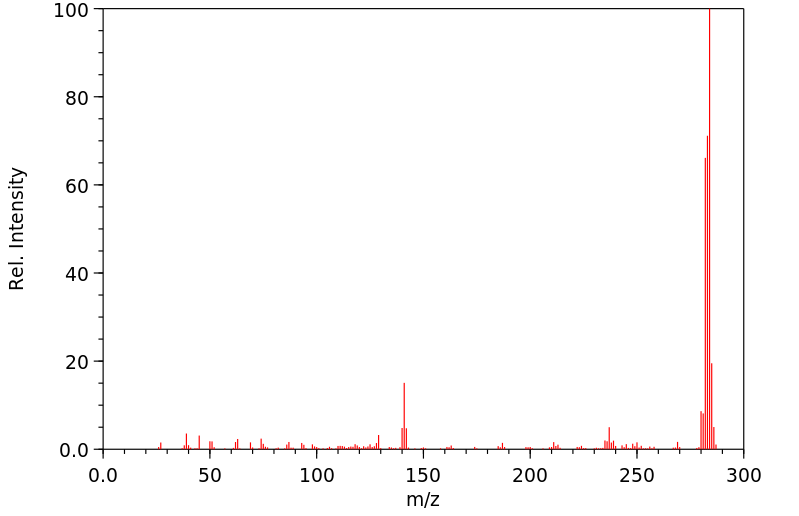1,1'-binaphthothiophene | 147923-24-8
中文名称
——
中文别名
——
英文名称
1,1'-binaphthothiophene
英文别名
dinaphtho[2,1-b:1',2'-d]thiophene;dinaphtho<2,1-b:1',2'-d>thiophene;Dinaphtho<2,1-b:1',2'-d>thiophen;dinaphthothiophene;12-thiapentacyclo[11.8.0.02,11.03,8.016,21]henicosa-1(13),2(11),3,5,7,9,14,16,18,20-decaene
CAS
147923-24-8
化学式
C20H12S
mdl
——
分子量
284.381
InChiKey
JFNCOYXPHARAMI-UHFFFAOYSA-N
BEILSTEIN
——
EINECS
——
-
物化性质
-
计算性质
-
ADMET
-
安全信息
-
SDS
-
制备方法与用途
-
上下游信息
-
文献信息
-
表征谱图
-
同类化合物
-
相关功能分类
-
相关结构分类
计算性质
-
辛醇/水分配系数(LogP):6.8
-
重原子数:21
-
可旋转键数:0
-
环数:5.0
-
sp3杂化的碳原子比例:0.0
-
拓扑面积:28.2
-
氢给体数:0
-
氢受体数:1
上下游信息
-
下游产品
中文名称 英文名称 CAS号 化学式 分子量 —— 6-hydroxymethyldinaphtho[2,1-b:1',2'-d]thiophene —— C21H14OS 314.408
反应信息
-
作为反应物:描述:1,1'-binaphthothiophene 在 bis(acetylacetonate)nickel(II) 乙基溴化镁 、 异丙基溴化镁 、 potassium carbonate 、 间氯过氧苯甲酸 作用下, 以 四氢呋喃 、 乙醚 、 二氯甲烷 、 丙酮 为溶剂, 反应 32.08h, 生成 2-iodo-1,1'-binaphthyl参考文献:名称:钯催化的双萘二甲酸铵盐的羰基化和羰基化反应形成功能化的2-碘-1,1'-联萘基摘要:在钯催化剂的存在下,双萘二甲铵鎓盐1的Heck型烯化和羰基化以高选择性高产率地得到相应的2-碘-2′-官能化的1,1′-联萘。DOI:10.1002/adsc.200404202
-
作为产物:描述:bis(2-naphthyl)sulfide 在 正丁基锂 、 四甲基乙二胺 、 potassium tert-butylate 作用下, 以 四氢呋喃 、 乙醚 为溶剂, 反应 0.02h, 以31%的产率得到1,1'-binaphthothiophene参考文献:名称:钯辅助的二苯并噻吩“芳香变态”成三亚苯基摘要:芳香族硫化合物的两个新的钯催化反应使二苯并噻吩在四个步骤中转化为苯并菲。一种芳族骨架向另一种芳族骨架的转化包括:1)二苯并噻吩的4-氯丁基化反应形成相应的sulf盐; 2)钯盐与四芳基硼酸钠的钯催化的芳基开环反应; 3)分子内S N 2反应以形成teraryl锍盐,和4)的钯催化的分子内ç S / C H至电palladation耦合。以量身定制的方式合成了所需的对称和不对称的三亚苯基,其总收率令人满意。DOI:10.1002/anie.201501992
文献信息
-
Asymmetric Synthesis of Axially Chiral Biaryls by Nickel-Catalyzed Grignard Cross-Coupling of Dibenzothiophenes作者:Yong-Hwan Cho、Asato Kina、Toyoshi Shimada、Tamio HayashiDOI:10.1021/jo035880p日期:2004.5.12-mercapto-2‘-substituted-1,1‘-biphenyls (8a−c) and 2-mercapto-2‘-substituted-1,1‘-binaphthyls (8d) in high yields. The mercapto group in the axially chiral cross-coupling products was converted into several functional groups by way of the methylsulfinyl group. The rate of flipping in dinaphthothiophene was measured by variable-temperature 31P NMR analysis of methylphenylphosphinyldinaphthothiophene derivative (21)
-
Thiolate-Initiated Synthesis of Dibenzothiophenes from 2,2′-Bis(methylthio)-1,1′-Biaryl Derivatives through Cleavage of Two Carbon–Sulfur Bonds作者:Yoshihiro Masuya、Yuki Kawashima、Takuya Kodama、Naoto Chatani、Mamoru TobisuDOI:10.1055/s-0037-1611974日期:2019.10A catalytic reaction involving the cleavage of two carbon–sulfur bonds in 2,2′-bis(methylthio)-1,1′-biaryl derivatives is reported. This reaction does not require a transition-metal catalyst and is promoted by a thiolate anion. Notably, based on DFT calculations, the product-forming cyclization step is shown to proceed through a concerted nucleophilic aromatic substitution (CSNAr) mechanism.
-
Cyclization of 2-Biphenylthiols to Dibenzothiophenes under PdCl<sub>2</sub>/DMSO Catalysis作者:Tao Zhang、Guigang Deng、Hanjie Li、Bingxin Liu、Qitao Tan、Bin XuDOI:10.1021/acs.orglett.8b02347日期:2018.9.7A palladium-catalyzed synthesis of dibenzothiophenes from 2-biphenylthiols is described. This highly efficient reaction employs a simple PdCl2/DMSO catalytic system, in which PdCl2 is the sole metal catalyst and DMSO functions as an oxidant and solvent. This transformation has broad substrate scope and operational simplicity and proceeds in high yield. The synthetic utility was demonstrated by the
-
Application of flash vacuum pyrolysis to the synthesis of sulfur-containing heteroaromatic systems作者:Koichi Imamura、Daigo Hirayama、Hitoshi Yoshimura、Kazuo Takimiya、Yoshio Aso、Tetsuo OtsuboDOI:10.1016/s0040-4039(99)00295-6日期:1999.4The FVP method of ethynyl and chlorovinyl materials is applied to the ready formation of sulfur-containing fused heteroaromatic systems. The pyrolysis of the chlorovinyl materials is assumed to involve a mechanism different from that of the ethynyl materials.
-
Opening and Hydrogenation of Dinaphtho[2,1-<i>b</i>:1‘,2‘-<i>d</i>]thiophene (DNT) by Soluble Rhodium and Iridium Complexes. Homogeneous Hydrogenolysis of DNT to 1,1‘-Binaphthalene-2-thiol by Rhodium Catalysis作者:Claudio Bianchini、Davide Fabbri、Serafino Gladiali、Andrea Meli、Wolfgang Pohl、Francesco VizzaDOI:10.1021/om9604785日期:1996.10.15with protic acids. The complex (triphos)RhH3 (6) reacts with DNT (THF, 70 °C) to give exclusively the dihydride thiolate product (triphos)Rh(H)2(SC20H13). The latter complex reacts in THF with KOBut in the presence of H2 (5 atm) at room temperature to give the trihydride 6 and potassium 1,1‘-binaphthalene-2-thiolate. In the presence of a strong base (KOBut), the π-alkyne complex [(triphos)Rh(η2-MeO2CC⋮CCO2Me)]PF6通过在乙醇中热解(triphos)Ir(H)2(C 2 H 5)原位生成的片段[(triphos)IrH]与萘甲酚[2,1- b:1',2'- d ]反应在温度噻吩(DNT)超过100℃更高,得到的温度不变3:在两个非对映体C-S插入的产品2的混合物(三磷酸)IRH(η 2(C ^,小号)-C 20 ħ 12 S)(3a,b ;三价= MeC(CH 2 PPh 2)3)。的温度范围内从70至100℃,将反应给出的C-S插入的产品和复合物(三磷酸)IRH(η的动能混合物2 -C 20 ħ 12 S)(2),该建议将包含完整的DNT分子通过来自萘基环的双键与铱结合。THF中的配合物2即使在70°C时也可转变为3a,b。的氢化图3a,b(30个大气压为h 2,60℃)在THF给出了二氢化硫醇盐复合物(三磷酸)的Ir(H)2(SC 20 ħ 13),这是由强酸质子化,转化为二聚物[(三磷酸)IRH(μ-SC
表征谱图
-
氢谱1HNMR
-
质谱MS
-
碳谱13CNMR
-
红外IR
-
拉曼Raman
-
峰位数据
-
峰位匹配
-
表征信息
同类化合物
(S)-溴烯醇内酯
(R)-3,3''-双([[1,1''-联苯]-4-基)-[1,1''-联萘]-2,2''-二醇
(3S,3aR)-2-(3-氯-4-氰基苯基)-3-环戊基-3,3a,4,5-四氢-2H-苯并[g]吲唑-7-羧酸
(3R,3’’R,4S,4’’S,11bS,11’’bS)-(+)-4,4’’-二叔丁基-4,4’’,5,5’’-四氢-3,3’’-联-3H-二萘酚[2,1-c:1’’,2’’-e]膦(S)-BINAPINE
(11bS)-2,6-双(3,5-二甲基苯基)-4-羟基-4-氧化物-萘并[2,1-d:1'',2''-f][1,3,2]二氧磷
(11bS)-2,6-双(3,5-二氯苯基)-4羟基-4-氧-二萘并[2,1-d:1'',2''-f][1,3,2]二氧磷杂七环
(11bR)-2,6-双[3,5-双(1,1-二甲基乙基)苯基]-4-羟基-4-氧化物-二萘并[2,1-d:1'',2''-f][1,3,2]二氧杂磷平
黄胺酸
马兜铃对酮
马休黄钠盐一水合物
马休黄
食品黄6号
食品红40铝盐色淀
飞龙掌血香豆醌
颜料黄101
颜料红70
颜料红63
颜料红53:3
颜料红5
颜料红48单钠盐
颜料红48:2
颜料红4
颜料红261
颜料红258
颜料红220
颜料红22
颜料红214
颜料红2
颜料红19
颜料红185
颜料红184
颜料红170
颜料红148
颜料红147
颜料红146
颜料红119
颜料红114
颜料红 9
颜料红 21
颜料橙7
颜料橙46
颜料橙38
颜料橙3
颜料橙22
颜料橙2
颜料橙17
颜料橙 5
颜料棕1
顺式-阿托伐醌-d5
雄甾烷-3,17-二酮







